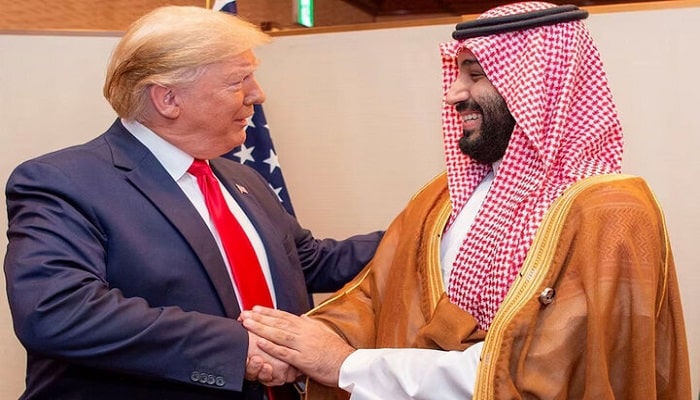PNN – The Saudi crown prince’s visit to Washington is not a ceremonial trip but a comprehensive deal aimed at redefining Saudi Arabia’s position in the international and regional order.
Mohammed bin Salman’s trip to Washington on November 18, 2025, is considered a turning point in Riyadh–Washington relations and one of the most significant geopolitical developments in the Middle East following Donald Trump’s return to the White House. This visit comes at a time when the region is facing multiple crises, including Iran’s nuclear tensions, the Gaza war, and the growing competition among emerging powers. After a period of relative isolation during the Biden administration, Saudi Arabia now sees Trump’s deal-based approach as an opportunity to secure a broad package of concessions and reestablish itself as America’s main strategic partner in the Persian Gulf. From Iran’s perspective, the visit is not merely a diplomatic meeting but an organized effort to shift the balance of power against the Axis of Resistance and to curb Tehran’s regional influence. The declared and undeclared goals of the trip range from nuclear issues to advanced weapons and new technologies, with the potential to reshape Middle Eastern security for the next decade.
Saudi Arabia seeks to break the nuclear taboo in the Middle East
One of Mohammed bin Salman’s most important unspoken goals is to obtain a US green light for access to the full nuclear fuel cycle, especially uranium enrichment on Saudi soil. For years, Riyadh has pressed Washington by referring to the terms of the US–Saudi 123 nuclear agreement and arguing: “If Iran has enrichment, we must have it too.” The Trump administration, which withdrew from the JCPOA during its first term and now holds a harsher anti-Iran stance, will likely agree to limited enrichment (below 5 percent) in exchange for hundreds of billions of dollars in Saudi investment in US infrastructure projects and purchases of US treasury bonds. Such a concession would weaken Iran’s relative monopoly over enrichment technology and allow Saudi Arabia to approach nuclear-threshold status in the near future. From Tehran’s viewpoint, this is a clear example of Washington’s double standards—calling Iran’s peaceful nuclear program a threat while granting special privileges to its Arab ally and triggering a dangerous nuclear rivalry in the region.
Read more:
Meeting at the White House; what happened at the press conference between Trump and Bin Salman?
Sale of F-35 fighter jets to Saudi Arabia
The sale of fifth-generation F-35 fighter jets to Saudi Arabia—halted during the Biden era due to human rights concerns and fears of undermining Israel’s qualitative military edge—is now likely to resume with Trump’s return. Trump has openly stated that he will welcome selling the jets to Riyadh. Since 2017, Saudi Arabia has been lobbying to buy at least 45 F-35s and is ready to pay over 40 billion dollars. Trump, who calls arms sales “creating American jobs,” is expected to push the deal through by bypassing congressional obstacles and offering confidential assurances to Israel.
Saudi Arabia’s push to develop its AI infrastructure
Alongside nuclear energy and advanced weaponry, artificial intelligence has become the third pillar of Saudi Arabia’s Vision 2030 strategy. During the crown prince’s visit, extensive cooperation with major American tech firms is a top priority. Riyadh plans to invest 100 billion dollars in joint funds to turn NEOM into the region’s largest AI hub and is inviting companies such as Nvidia, Microsoft, and OpenAI to transfer technology and set up research centers. The Trump administration, viewing AI competition with China as a national priority, is expected to ease export restrictions for Saudi Arabia. This cooperation will transform the kingdom from an oil-based economy into a technological actor and significantly strengthen its cyber and electronic warfare capabilities against Iran. From the perspective of Iranian political elites, this trend is part of a broader Western project aimed at sidelining Tehran from the global innovation chain and creating an irreversible technological gap between the two countries.
Intensifying geopolitical competition in the Middle East
The future regional order is one of the most important issues behind this visit. Backed by Trump’s unconditional support, Saudi Arabia aims to become the central pillar of a US-Arab-Israeli coalition against Iran. Riyadh hopes that through full normalization with Israel and the establishment of a joint security umbrella, it can help form a “Middle Eastern NATO” that isolates Iran entirely. At the same time, by attracting large American investments, Saudi Arabia intends to marginalize Turkey and Qatar and reclaim leadership of the Sunni world. Such a new order would place the Axis of Resistance in a defensive position and could intensify conflicts in Yemen, Lebanon, Syria, and Iraq. However, internal contradictions within the kingdom, its deep dependence on oil, and growing competition from China and Russia cast doubt on the durability of this proposed order.
Conclusion
Ultimately, the crown prince’s trip to Washington goes far beyond a ceremonial visit. It is a comprehensive deal to redefine Saudi Arabia’s position in the global and regional order. Securing enrichment rights, purchasing F-35 jets, expanding cooperation in artificial intelligence, and pushing for leadership of an anti-Iran alliance all reflect Riyadh’s determination to become a dominant power in the Persian Gulf. From Iran’s viewpoint, these developments represent a multi-layered threat to national security and strategic deterrence and could trigger dangerous nuclear, military, and technological competition. To counter this strategy, Tehran may need to strengthen independent diplomacy with eastern powers, accelerate its missile and cyber programs, and use its regional leverage more strategically.

